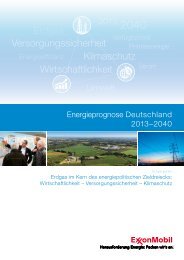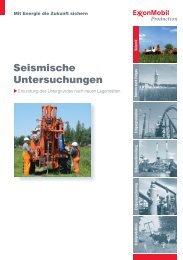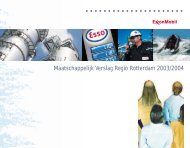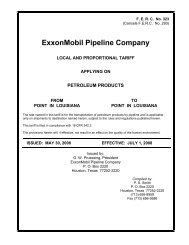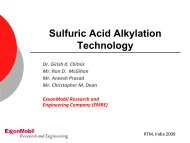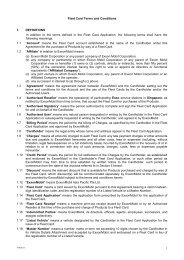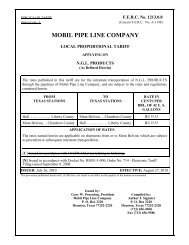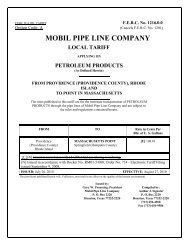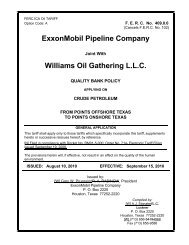ExxonMobil and Abu Dhabi
ExxonMobil and Abu Dhabi
ExxonMobil and Abu Dhabi
You also want an ePaper? Increase the reach of your titles
YUMPU automatically turns print PDFs into web optimized ePapers that Google loves.
Meeting global energy<br />
<strong>and</strong> environmental challenges through innovation<br />
3<br />
Chairman Tillerson began his<br />
speech by saluting six years of<br />
promising energy research at the<br />
Stanford-based Global Climate<br />
<strong>and</strong> Energy Project (GCEP),<br />
founded in 2002 with <strong>ExxonMobil</strong><br />
as lead sponsor. He noted that<br />
GCEP’s network of scientists,<br />
engineers, researchers <strong>and</strong> students<br />
involves 20 research institutions<br />
on four continents, with<br />
Stanford at the hub. “GCEP’s<br />
work is ultimately about laying<br />
the scientific foundations for<br />
practical problem-solving that will<br />
help advance broad-based commercial<br />
solutions,” he said.<br />
Technology, said Tillerson, is<br />
the single, most vital element that<br />
should unite all efforts to attain<br />
our energy <strong>and</strong> environmental<br />
goals. He said <strong>ExxonMobil</strong> has<br />
invested more than $6 billion in<br />
technology in just the past six<br />
years, <strong>and</strong> maintains several<br />
company research centers in the<br />
United States <strong>and</strong> elsewhere.<br />
“Our 14,000 scientists <strong>and</strong> engineers<br />
are part of the broader<br />
technical <strong>and</strong> scientific community<br />
dedicated to energy <strong>and</strong><br />
environmental problem-solving<br />
through technology innovation.”<br />
Oil, natural gas continue as<br />
prime energy sources<br />
While the current global economic<br />
downturn has reduced<br />
energy dem<strong>and</strong> <strong>and</strong> prices,<br />
Tillerson said the world econ-<br />
Story by Thomas L. Torget<br />
In a February speech at Stanford University,<br />
<strong>ExxonMobil</strong> Chairman <strong>and</strong> CEO Rex W. Tillerson<br />
described the critical role of technology in meeting<br />
the challenge of delivering more energy while<br />
reducing greenhouse gas emissions.<br />
omy will recover, <strong>and</strong> so too will<br />
energy dem<strong>and</strong>.<br />
Growing populations in<br />
developing countries will drive<br />
increased energy dem<strong>and</strong>, which<br />
is expected to be 35 percent<br />
higher in 2030 than in 2005.<br />
Meeting this dem<strong>and</strong> requires<br />
that we develop all economic<br />
<strong>and</strong> environmentally sound<br />
sources of energy, including oil<br />
<strong>and</strong> natural gas, which Tillerson<br />
described as “abundant, available,<br />
versatile <strong>and</strong> affordable.”<br />
Tillerson noted that huge<br />
investments over many decades<br />
have enabled oil <strong>and</strong> gas to meet<br />
nearly 60 percent of world energy<br />
needs today, <strong>and</strong> that these<br />
same fuels will meet the majority<br />
of world energy dem<strong>and</strong> through<br />
at least 2030. Alternatives such<br />
as solar, wind, nuclear <strong>and</strong> biofuels<br />
will make a significant <strong>and</strong><br />
growing contribution, but no<br />
single energy source solves the<br />
dual challenge of meeting growing<br />
energy needs while reducing<br />
emissions. “For now <strong>and</strong> the foreseeable<br />
future, an integrated set<br />
of solutions is required,” he said.<br />
Turning to environmental<br />
challenges, Tillerson explained<br />
that thanks to greater energy<br />
efficiency <strong>and</strong> growing use of<br />
cleaner fuels such as natural<br />
gas, greenhouse gas emissions<br />
are expected to decline in some<br />
developed economies. U.S.<br />
energy-related carbon-dioxide<br />
emissions are approaching a<br />
plateau <strong>and</strong> will decrease over<br />
the next two decades, he said.<br />
“These trends are set to continue<br />
<strong>and</strong> potentially accelerate,<br />
not only in the United States but<br />
in other developed economies<br />
as well.”<br />
Greenhouse gas emissions<br />
to rise in developing nations<br />
But the challenge of reducing<br />
greenhouse gas emissions is<br />
more daunting for developing<br />
economies, said Tillerson. “By<br />
2030 China’s carbon-dioxide<br />
emissions will be comparable<br />
to those of the United States<br />
<strong>and</strong> Europe combined,” he said.<br />
“Even with dramatic gains in efficiency,<br />
rising dem<strong>and</strong> for energy<br />
will continue to push related<br />
carbon-dioxide emissions higher<br />
through 2030, an increase of 28<br />
percent from 2005.”<br />
Tillerson noted that any new<br />
technology – however promising<br />
– faces practical barriers in<br />
bringing it to the energy marketplace.<br />
These barriers include<br />
performance, cost, safety,<br />
environmental impacts <strong>and</strong> consumer<br />
acceptance.<br />
He said <strong>ExxonMobil</strong>’s integrated<br />
approach to increasing<br />
supplies <strong>and</strong> reducing emissions<br />
is exemplified by the company’s<br />
Global Energy Management<br />
System. The system involves daily<br />
tracking of more than 12,000<br />
energy variables throughout the<br />
company’s refining, marketing<br />
<strong>and</strong> chemical operations. “Since<br />
2000, we have identified $1.5 billion<br />
in potential efficiency savings,<br />
<strong>and</strong> approximately 60 percent of<br />
those savings have been captured<br />
to date,” he added.<br />
New technologies<br />
in transportation<br />
Tillerson mentioned several<br />
<strong>ExxonMobil</strong> technologies that<br />
are improving energy efficiency in<br />
the transportation sector. These<br />
include tire liners that keep tires<br />
inflated longer, advanced fuel




